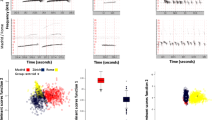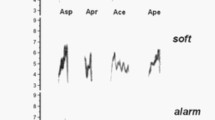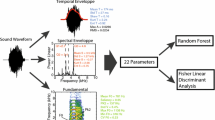Abstract
The S-type vocalizations of three populations ofCtenomys from Uruguay were compared: two ofCtenomys pearsoni Lessa and Langguth, 1983 from Penino and Relincho and the third from a different karyomorph of the genus (Solís karyomorph). Ten rhythm and 3 frequency variables were used for discriminant analysis. The results showed that a set of nine variables allowed a complete separation of the populations. The two C.pearsoni populations were correctly discriminated from one another using four variables, the differences lying especially in the rhythm domain. Information about the general biology and distribution of the animals suggest that these differences could be explained as a product of chance variations and later fixation of the variants in local populations. The Solís karyomorph was also correctly discriminated from the other populations using four variables, but main frequency seems to play an important role in this case.
Similar content being viewed by others
References
Bradbury J. W. and Vehrencamp S. L. 1998. Principles of animal communication. Sinauer, Sunderland: 1–882.
Credner, S., Burda H. and Ludescher F. 1997. Acoustic communication underground: vocalization characteristics in subterranean social mole-rats (Cryptomys sp., Bathyergidae). Journal of Comparative Physiology A 180: 245–255.
D’Elia G., Ubilla M. and Altuna C. A. 1992. Características discriminantes y morfofuncionales de la pelvis en poblaciones deCtenomys (Rodentia, Octodontidae) del Uruguay. Boletín de la Sociedad Zoológica del Uruguay (2Ş época) 7: 41–42.
Francescoli G. 1998. La comunicación acústica en poblaciones deCtenomys (Rodentia, Octodontidae) de Uruguay, con algunas consideraciones sobre el uso del canal “vibratorio” por los roedores subterraneos. PEDECIBA-Universidad de la República Oriental del Uruguay, Montevideo: vi+151.
Francescoli G. 1999. A preliminary report on the acoustic communication in UruguayanCtenomys (Rodentia, Octodontidae): basic sound types. Bioacoustics 10: 203–218.
Francescoli G. 2000. Sensory capabilities and communication in subterranean rodents. [In: Life underground. The biology of subterranean rodents. E. A. Lacey, J. L. Patton and G. N. Cameron, eds]. The University of Chicago Press, Chicago: 111–144.
Francescoli G. and Altuna C. A. 1998. Vibrational communication in subterranean rodents: The possible origin of different strategies. Evolution of Communication 2(2): 217–231.
Heth G., Frankenberg E., Pratt H. and Nevo E. 1991. Seismic communication in the blind subterranean mole-rat: patterns of head thumping and their detection in theSpalax ehrenbergi superspecies in Israel. Journal of Zoology, London 224: 633–638.
Lacey E. A., Braude S. H. and Wieczorek J. R. 1997. Burrow sharing by colonial tuco-tucos (Ctenomys sociabilis). Journal of Mammalogy 78: 556–562.
Mundinger P. C. 1982. Microgeographic and macrogeographic variation in the acquired vocalizations of birds. [In: Acoustic communication in birds. Vol. 2. D. E. Kroodsma and E. H. Miller, eds]. Academic Press, New York: 147–208.
Nevo E. 1990. Evolution of nonvisual communication and photoperiodic perception in speciation and adaptation of blind subterranean mole rats. Behaviour 114: 249–276.
Nevo E., Heth G., Beiles A. and Frankenberg E. 1987. Geographic dialects in blind mole rats: role of vocal communication in active speciation. Proceedings of the National Academy of Sciences USA 84: 3312–3315.
Pearson O. P. 1959. Biology of the subterranean rodents,Ctenomys, in Peru. Memorias del Museo de Historia Natural “Javier Prado” 9: 3–56.
Pearson O. P. and Christie M. I. 1985. Los tuco-tucos (géneroCtenomys) de los Parques Nacionales Lanin y Nahuel Huapi, Argentina. Historia Natural (Corrientes) 5: 337–343.
Pepper J. W., Braude S. H., Lacey E. A. and Sherman P. W. 1991. Vocalizations of the naked mole-rat. [In: The biology of the naked mole-rat. P. W. Sherman, J. U. M. Jarvis and R. D. Alexander, eds]. Princeton University Press, Princeton: 243–274.
Reig O. A., Busch C., Ortells M. O. and Contreras J. R. 1990. An overview of evolution, systematics, population biology, cytogenetics, molecular biology and speciation inCtenomys. [In: Evolution of subterranean mammals at the organismal and molecular levels. E. Nevo and O. A. Reig, eds]. Wiley-Liss, New York: 71–96.
Slobodchikoff C. N., Ackers S. H. and Van Ert M. 1998. Geographic variation in alarm calls of Gunnison’s prairie dogs. Journal of Mammalogy 79: 1265–1272.
StatSoft. 1984–1995. STATISTICA for Windows. Version 5.0 StatSoft Inc., Tulsa.
Author information
Authors and Affiliations
Rights and permissions
About this article
Cite this article
Francescoli, G. Geographic variation in vocal signals ofCtenomys pearsoni . Acta Theriol 47, 35–44 (2002). https://doi.org/10.1007/BF03193564
Received:
Accepted:
Issue Date:
DOI: https://doi.org/10.1007/BF03193564




